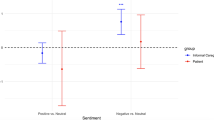Abstract
Telehealth has the potential to improve patient access to professional healthcare. In this paper we examine the publicly held perceptions of healthcare professionals on Twitter regarding telehealth platforms pre and during the COVID-19 pandemic. Sentiment analysis and Epistemic Network Analysis (ENA) were used to investigate whether there were changes in the perceptions and opinions of telehealth expressed on Twitter by healthcare professionals between the time period of January to April 2019 and January to May 2020, during the initial medical system response to COVID-19. Findings suggest that professionals’ perceptions shifted from telehealth as innovation during COVID-19 to focus on the pervasive need for safe access and delivery to care. Overall, sentiment on telehealth was found to be positive, with advances made in payment for telehealth care delivery and the easing of some of the restrictions on telehealth practice in 2020, though concerns on access to care through telehealth platforms remain prevalent.
Access this chapter
Tax calculation will be finalised at checkout
Purchases are for personal use only
Similar content being viewed by others
References
Zucco, C., Bella, S., Paglia, C., Tabarini, P., Cannataro, M.: Predicting abandonment in telehomecare programs using sentiment analysis: a system proposal. In: IEEE International Conference on Bioinformatics and Biomedicine (BIBM), pp. 1734–1739 (2018)
Moore, J.H., et al.: Ideas for how informaticians can get involved with COVID-19 research. BioData Min. 13(1), 1–16 (2020)
Zhou, X., et al.: The role of telehealth in reducing the mental health burden from COVID-19. Telemed e-Health 26(4), 377–379 (2020)
Virtual Care: Access Michigan Medicine Healthcare Online. University of Michigan (2020)
Rosenbaum, E.: Robotic medicine may be the weapon the world needs to combat the coronavirus. CNBC (2020)
Smith, A.C., et al.: Telehealth for global emergencies: implications for coronavirus disease 2019 (COVID-19). J. Telemed. Telecare. 26(5), 309–313 (2020)
Hollander, J.E., Carr, B.G.: Virtually Perfect? Telemedicine for COVID-19. N. Engl. J. Med. 382(18), 1679–1681 (2020)
Talpada, H., Halgamuge, M.N., Tran Quoc Vinh, N.: An analysis on use of deep learning and lexical-semantic based sentiment analysis method on twitter data to understand the demographic trend of telemedicine. In: 11th International Conference on Knowledge and Systems Engineering (KSE), Da Nang, pp. 1–9 (2019)
Stine, R.A.: Sentiment analysis. Annu. Rev. Stat. Appl. 6, 287–308 (2019)
Kušen, E., Strembeck, M.: Politics, sentiments, and misinformation: an analysis of the Twitter discussion on the 2016 Austrian Presidential Elections. Online Soc. Netw. Media [Internet] 5, 37–50 (2018). https://doi.org/10.1016/j.osnem.2017.12.002
Hassan, A.U., Hussain, J., Hussain, M., Sadiq, M., Lee, S.: Sentiment analysis of social networking sites (SNS) data using machine learning approach for the measurement of depression. In: International Conference on Information and Communication Technology Convergence (ICTC), pp. 138–40, Jeju 2017
Zou, X., Yang, J., Zhang, J.: Microblog sentiment analysis using social and topic context. PLoS ONE 13(2), 1–24 (2018)
Shaffer, D.W.: Quantitative Ethnography. Cathcart Press, Madison (2017)
Sullivan, S., et al.: Using epistemic network analysis to identify targets for educational interventions in trauma team communication. Surg. (United States) [Internet] 163(4), 938–43 (2018). https://doi.org/10.1016/j.surg.2017.11.009
Wooldridge, A.R., Carayon, P., Shaffer, D.W., Eagan, B.: Human factors case study of task-allocation communication in. ISE Trans. Heal. Syst. Eng. 8(1), 72–82 (2019)
Demsar, J., et al.: Orange: data mining toolbox in Python. J. Mach. Learn. Res. 14(1), 2349–2353 (2013)
Hu, M., Liu, B.: Mining and summarizing customer reviews. In: KDD-2004 – Proceedings of the Tenth ACM SIGKDD International Conference on Knowledge Discovery and Data Mining, pp. 168–177 (2004)
Hsieh, H.F., Shannon, S.E.: Three approaches to qualitative content analysis. Qual. Health Res. 15(9), 1277–1288 (2005)
Shaffer, D.W., Collier, W., Ruis, A.R.: A tutorial on epistemic network analysis: analyzing the structure of connections in cognitive, social, and interaction data. J. Learn. Anal. 3(3), 9–45 (2016)
Shaffer, D.W., Ruis, A.R.: Epistemic network analysis: a worked example of theory-based learning analytics. Handb. Learn. Anal., 175–87 (2017)
Marquart, C.L., Hinojosa, C., Swiecki, Z., Eagan, B., Shaffer, D.W.: Epistemic Network Analysis [Internet] (2018). http://app.epistemicnetwork.org
Siebert-evenstone, A.L., Collier, W., Ruis, A.R., Shaffer, D.W.: In search of conversational grain size: modelling semantic structure using moving stanza windows Golnaz Arastoopour Irgens Wisconsin Center for Education Research University of Wisconsin – Madison, United States University of Wisconsin – Madison. Unite. J Learn Anal. 4(3), 123–139 (2017)
Arastoopour, G., Shaffer, D.W., Swiecki, Z., Ruis, A.R., Chesler, N.C.: Teaching and assessing engineering design thinking with virtual internships and epistemic network analysis. Int. J. Eng. Educ. 32(3), 1492–1501 (2016)
Author information
Authors and Affiliations
Corresponding author
Editor information
Editors and Affiliations
Rights and permissions
Copyright information
© 2021 Springer Nature Switzerland AG
About this paper
Cite this paper
Larson, S., Popov, V., Ali, A.M., Ramanathan, P., Jung, S. (2021). Healthcare Professionals’ Perceptions of Telehealth: Analysis of Tweets from Pre- and During the COVID-19 Pandemic. In: Ruis, A.R., Lee, S.B. (eds) Advances in Quantitative Ethnography. ICQE 2021. Communications in Computer and Information Science, vol 1312. Springer, Cham. https://doi.org/10.1007/978-3-030-67788-6_27
Download citation
DOI: https://doi.org/10.1007/978-3-030-67788-6_27
Published:
Publisher Name: Springer, Cham
Print ISBN: 978-3-030-67787-9
Online ISBN: 978-3-030-67788-6
eBook Packages: Computer ScienceComputer Science (R0)




